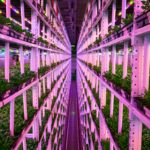 A recent study led by the University of Michigan shows that fruit and vegetables from city farms have a carbon footprint six times bigger than those grown the usual way.
A recent study led by the University of Michigan shows that fruit and vegetables from city farms have a carbon footprint six times bigger than those grown the usual way.
But there’s a twist. Some crops grown in the city did just as well or even better than regular farming in certain situations. For instance, tomatoes grown in open-air city plots had a smaller carbon footprint than ones raised in regular greenhouses. And for air-freighted crops like asparagus, the difference in emissions between city and regular farming wasn’t noticeable. The study breaks down the carbon footprint differences between city and regular farming, giving us a closer look at how they compare.
“The exceptions revealed by our study suggest that urban agriculture practitioners can reduce their climate impacts by cultivating crops that are typically greenhouse-grown or air-freighted, in addition to making changes in site design and management,” the researchers explain.
“Urban agriculture offers a variety of social, nutritional and place-based environmental benefits, which make it an appealing feature of future sustainable cities. This work shines light on ways to ensure that urban agriculture benefits the climate, as well as the people and places it serves.”
The rise of urban agriculture
As more people worldwide are getting into urban agriculture – growing food in city limits – it’s seen as a way to make cities and their food systems more sustainable. Stats say around 20% to 30% of the global city population is into some kind of urban farming.
Even though we know urban farming has social and nutritional perks, not much attention has been given to its carbon footprint. Most studies so far focused on high-tech forms like vertical farms and rooftop greenhouses, but the majority of urban farms are actually low-tech, growing crops in open-air plots.
The study digs into the carbon footprints of low-tech urban farms compared to regular crops. They looked at data from 73 urban farms in five countries – the biggest study of its kind. They checked out three types of urban farms: professional urban farms, small individual gardens, and communal gardens managed by groups.
The researchers figured out the greenhouse gas emissions linked to the materials and activities on each farm over its lifespan. When compared to conventionally grown produce, they found that, on average, urban agriculture produced 0.42 kilograms of carbon dioxide equivalents per serving, which is six times more than the 0.07 kg CO2e per serving from regular farming.
“By assessing actual inputs and outputs on urban agriculture sites, we were able to assign climate change impacts to each serving of produce,” the researchers explain. “This dataset reveals that urban agriculture has higher carbon emissions per serving of fruit or vegetable than conventional agriculture—with a few exceptions.”
Making things better
For low-tech city farming to compete with regular farming on the carbon front, the researchers suggest following three key tips:
- Make Things Last Longer: Keep urban farming materials like raised beds and sheds in use for as long as possible. A raised bed used for 20 years has way less impact on the environment per serving of food than one used for just 5 years.
- Turn City Waste into Farm Resources: Get creative with recycling in urban areas. Instead of tossing things out, find ways to use materials like old building stuff for farming. This could include reusing rainwater and recycled grey water for watering crops.
- Boost Social Benefits: Urban farmers often report feeling happier and healthier. While this doesn’t directly cut carbon, the researchers argue that if urban farms bring more social benefits, they can outshine regular farming when you look at the big picture.